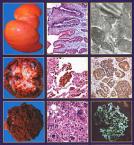Pathological anatomy consists of three main sections:
1. General pathological anatomy - the doctrine about typical pathological processes (metabolic disorders, blood and lymph circulation, inflammation, immunopathological processes, regeneration, atrophy, hypertrophy, tumor growth, necrosis, etc.).
2. The private (special) pathological anatomy studies the morphological manifestations of certain diseases (nosology forms), such as tuberculosis, rheumatism, liver cirrhosis, etc.
Disease (nosological form, disease entities) - a pathological process characterized by common etiology, pathogenesis, clinical and morphological manifestations, as well as approaches to its treatment. Nosological forms are represented by several syndromes, which in turn are a collection of symptoms (specific symptoms of pathological process).
3. Pathologic Practice - teaching about the organization of pathoanatomical service and practice pathologists.
The doctor pathologist carries lifetime and posthumous morphological diagnosis of pathological processes. Intravital morphological diagnosis is carried out on the material of biopsies and promptly deleted of organs or their parts. The results of morphological studies issued in the form mortem diagnosis or conclusion. The most important Pathologic diagnosis is in oncology.
Basic questions of general pathological anatomy
1. alterative processes
- Destructive processes (natural apoptosis)
- Parenchymal degeneration
- Mesenchymal dystrophy
- Mixed dystrophy (Endogenous pigments)
2. The process of adaptation and compensation
3. Tumor growth
- The etiology of cancer
- Tumors of Childhood
- Mesenchymal tumor
4. dyscirculatory processes
- Circulatory disorders
- Violations of lymph
5. The inflammatory response
6. Immunological processes
- Primary immunodeficiencies
7. Terminal states
8. Malformations of tissues and organs
Actual problems of private pathologic anatomy
1. Diseases of the blood
- Anemia
- Hemoblastosis
2. Rheumatism and diffuse connective tissue disease
3. Diseases of the cardiovascular system
4. Respiratory diseases
5. Diseases of the stomach and intestine
6. Liver Disease
7. Kidney disease
8. Pathology of the endocrine system
9. Diseases of the genital organs
- Pathological anatomy of the female reproductive system
- Pathological anatomy of the male reproductive system
10. Diseases of the nervous system
11. Diseases of bones and joints
12. Diseases of the skin
13. Viral infections
14. The bacterial intestinal infections
15. Children infections
- Viral infections Children
- Bacterial infections Children
- Intrauterine infection
16. Tuberculosis
17. Syphilis
18. Sepsis
19. Pathological anatomy of the prenatal period
20. Pathological anatomy of perinatal period
21. Pathological anatomy of the maxillofacial region
- Pathological anatomy of hard tissues of the tooth
- Pathological anatomy of the dental pulp and periodontal
- Pathological anatomy glossitis, cheilitis and stomatitis (Allergic stomatitis and dermatostomatity)
- Pathological anatomy of the jaw bones
Sialoadenopatii
22. Pathological anatomy of occupational diseases
- Diseases caused by pathogenic physical nature
- The biological effects of ionizing radiation
- Pneumoconiosis
Questions of mortem practice
1. The organization of pathoanatomical service
2. Technique autopsy
3. Protocol autopsy
4. Work with surgical and biopsy material
hide
 Pathology - Scientific and applied discipline that studies the pathological processes and disease through scientific, mainly microscopic, study of the changes occurring in cells and tissues. Pathological process - any breach of the structure and function, and disease - a combination of one or more of the pathological processes that lead to the disruption of the normal functioning of the body and the condition.
Pathology - Scientific and applied discipline that studies the pathological processes and disease through scientific, mainly microscopic, study of the changes occurring in cells and tissues. Pathological process - any breach of the structure and function, and disease - a combination of one or more of the pathological processes that lead to the disruption of the normal functioning of the body and the condition. 






